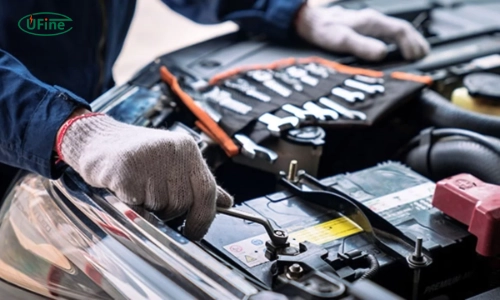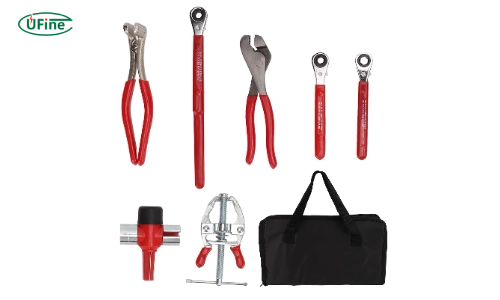
- Part 1. Why are lithium battery terminals are sensitive to over-tightening
- Part 2. Tools you need to tighten a battery post adapter safely
- Part 3. Recommended torque settings for lithium battery terminals
- Part 4. How to tighten a battery post adapter step by step
- Part 5. Mistakes to avoid when tightening battery post adapters
- Part 6. How to prevent thread damage during installation?
- Part 7. How to tighten different types of battery post adapters?
- Part 8. Signs you have overtightened a battery post adapter
- Part 9. Long-term maintenance to keep your battery post adapter safe
- Part 10. FAQs
Lithium batteries—especially LiFePO₄ batteries—use threaded terminals (M6 or M8) instead of traditional lead-acid posts. These threaded inserts are strong, reliable, and stable under high current, but they require careful handling. When installing a battery post adapter—whether SAE posts, copper bus bars, or ring terminal mounts—the most significant risk is overtightening. Too much torque can crack the terminal, strip the threads, deform the adapter, or, in the worst case, damage the internal battery structure.
This article explains how to safely tighten a battery post adapter, including the correct torque settings, the tools to use, common mistakes to avoid, and long-term maintenance tips. Whether you’re installing an adapter for an RV battery, a solar system, a trolling motor, a backup power bank, or a DIY energy storage system, this guide ensures you do it correctly—without damaging your lithium battery.
Part 1. Why are lithium battery terminals are sensitive to over-tightening
Lithium batteries—especially LiFePO₄ packs—typically use threaded metal inserts rather than solid lead posts. These inserts are strong, but they are embedded in the battery case. Unlike lead-acid batteries, whose terminals are part of the moulded structure, lithium battery inserts rely on:
- A fixed length of embedded metal
- Internal support beneath the terminal
- A limited thread depth (much shallower than automotive studs)
- Precise thread engagement
Because of these factors, applying excessive torque can cause:
- 1. Thread stripping
- The stainless-steel or brass insert becomes damaged, making it impossible to secure a bolt again.
- 2. Terminal cracking
- Too much force can break the surrounding material, risking battery failure.
- 3. Internal cell damage
- If a bolt bottoms out, the pressure can push against the internal components.
- 4. Loosened terminal inserts
- Over-tightening can cause the insert to rotate inside the battery case, requiring a full replacement.
- 5. Warranty voiding
- Manufacturers specify torque limits, and exceeding them can void your battery warranty.
Because of these risks, the tightening process must follow specific rules.
Part 2. Tools you need to tighten a battery post adapter safely
A safe and secure installation begins with the right tools. The goal is not only to avoid overtightening but also to achieve consistent and even pressure.
- 1. Torque wrench (mandatory)
- The most important tool is a small-scale torque wrench capable of measuring:
- 3–10 N·m
- 25–90 in-lb
- Most lithium battery terminals fall within this range.
- 2. Correct-size hex/Allen keys or sockets
- Depending on the manufacturer, adapters may use:
- Hex bolts
- Allen bolts
- Socket-head bolts
- Using the wrong tool deforms the bolt head.
- 3. Small ratchet or wrench (for pre-positioning)
- Used only to position the bolt—final tightening must be done with the torque wrench.
- 4 .Anti-corrosion paste or dielectric grease
- Helps prevent oxidation on the connection surface.
- 5. Flat washers and lock washers
- Optional, but recommended for:
- Marine installations
- RV systems
- Vibration-heavy environments
Part 3. Recommended torque settings for lithium battery terminals
Each manufacturer may have slightly different requirements, but the industry-standard torque values for LiFePO₄ threaded terminals are:
- M6 terminals (small LiFePO₄ batteries):
- 3–5 N·m
- (26–44 in-lb)
- M8 terminals (medium to large LiFePO₄ batteries):
- 6–9 N·m
- (53–80 in-lb)
- SAE post adapters (M6/M8 base):
- 5–7 N·m for M6-based adapters
- 7–9 N·m for M8-based adapters
Important rule: Never exceed the upper limit, and never “guess by feel.” Lithium terminals do not tolerate over-tightening like lead-acid posts.
Artikel Terkait: Battery Post Adapter Sizing Chart
Part 4. How to tighten a battery post adapter step by step
This section provides a safe and repeatable method for tightening any battery post adapter onto a lithium terminal—whether it’s an SAE converter, a stud adapter, a copper busbar, or a ring-terminal stack.
Clean the contact surfaces
Remove dust and oxidation, and ensure the adapter sits flush. Dirty surfaces increase resistance and heat.
- Remove dust
- Remove oxidation
- Ensure the adapter sits flush
Match the correct bolt length
A bolt that is too long will bottom out, apply downward pressure, crack the terminal, and damage the internal connection. Rule of thumb: Use only bolts supplied by the battery or adapter manufacturer.
- A bolt that is too long will bottom out and crack the terminal
Add washers if necessary
Use washers only when recommended. They help distribute pressure and improve stability.
- Use a flat washer to spread pressure
- Use a lock washer only if manufacturer-approved
Position the adapter
Place the adapter manually, ensuring it sits straight and flush. A misaligned adapter will deform under torque.
- Place the adapter manually
- Ensure it sits straight and flush
- Nothing should be tilted or forced
Hand-tighten first
Thread the bolt by hand until snug to prevent cross-threading.
Use a torque wrench for final tightening
Set the torque wrench correctly and tighten slowly until it clicks. Do not add force afterward.
- Set the torque wrench to the correct value
- M6 → 3–5 N·m / M8 → 6–9 N·m
- Turn slowly until the wrench clicks
- Stop immediately after the click
Support heavy cables
Heavy-gauge wires may apply sideways force. Supporting the cables reduces vibration stress on the adapter.
- High-gauge wires may apply sideways force
- Use zip ties, clamps, or brackets
Inspect for movement
Gently wiggle the adapter. It should not rotate, lift, or shift. If it moves, reassemble and repeat.
- Try gently wiggling the adapter
- Ensure no rotation or lifting
Part 5. Mistakes to avoid when tightening battery post adapters
This section is important because most terminal failures come from incorrect installation—not from the adapter itself.
- ❌ 1. Using the wrong bolt length
- A bolt that is too long can bottom out and push into the battery.
- Signs of bottoming out:
- Bolt suddenly becomes “tight” before the adapter is secure
- The terminal makes a cracking sound
- Adapter is still loose even when the bolt is tight
- This is the #1 cause of lithium terminal damage.
- ❌ 2.Overtightening the bolt
- More torque does not equal a better connection.
- Over-tightening causes:
- Thread stripping
- Terminal cracking
- Internal cell damage
- Warranty voiding
- Always use a torque wrench.
- ❌ 3. Using power tools
- Impact drivers and drills must never be used.
- They apply inconsistent torque and violent force.
- ❌ 4. Stacking too many ring terminals
- More than 2–3 terminals reduces the contact area and increases heat.
- For multiple connections, use a busbar instead.
- ❌ 5.Using steel or aluminum adapters
- Low-conductivity metals increase resistance and heat.
- Always choose:
- Copper
- Tin-plated copper
- Brass
- ❌ 6.Allowing cables to pull sideways
- Side pressure causes loosened adapters, bent bolts, and rotating inserts.
- All cables must be fully supported.
- ❌ 7.Tightening only one side of a multi-bolt busbar
- Uneven pressure leads to overheating.
- All bolts must be torqued evenly.
Part 6. How to prevent thread damage during installation?
Lithium terminals are durable but not indestructible. The following techniques prevent stripping and protect the terminal threads.
- 1. Always start bolts by hand
- This ensures the threads catch properly.
- Prevents cross-threading and terminal damage.
- 2 .Lubricate lightly if allowed
- Some manufacturers allow a tiny amount of dielectric grease on bolt threads.
- Always check the battery manual before applying any lubricant.
- 3. Use bolts with the correct thread pitch
Most lithium battery terminals use:
- M6 × 1.0
- M8 × 1.25
Using the wrong thread pitch instantly damages the terminal threads.
- 4. Never force a bolt
If you feel unexpected resistance while hand-threading:
- Stop
- Back out
- Re-align
Forcing the bolt will destroy the threads.
- 5. Replace damaged bolts immediately
- A worn or rounded bolt head increases the risk of tool slippage.
- Damaged bolts prevent proper torque application and should be replaced.
Part 7. How to tighten different types of battery post adapters?
Different adapters require different tightening techniques. This section breaks down the recommended method for each type.
- 1. SAE post adapters (M6 or M8 base)
These adapters convert lithium terminals to standard automotive posts.
How to tighten:
- Set the adapter flush on the terminal
- Hand-thread the bolt
- Torque to specification (usually 5–9 N·m)
- Tighten the top clamp after the base is secure
Important: Do not overtighten the clamp on the post—this can rotate the entire adapter.
- 2. Copper busbar adapters
Used for high-current applications such as inverters, solar charge controllers, or power distribution blocks.
How to tighten:
- Ensure full surface contact
- Use flat washers under bolt heads
- Tighten each bolt in alternating order
- Verify that the busbar does not flex
Busbars require balanced torque to prevent uneven heating.
- 3. Ring-terminal stack adapters
This adapter style allows multiple ring terminals to be stacked.
How to tighten:
- Arrange the terminals from largest to smallest
- Keep the maximum stack within manufacturer limits
- Use longer bolts only if approved
- Tighten slowly and evenly
If the stack is too tall, switch to a busbar.
- 4. Right-angle adapters
These adapters reroute cables in tight battery boxes or compartments.
How to tighten:
- Hold the adapter in position to prevent rotation
- Tighten the bolt to specification
- Support the cables to prevent sideways pull
Right-angle adapters are sensitive to twisting forces.
- 5. Heavy-duty stud adapters
These provide large threaded posts for high-current connections.
How to tighten:
- Seat the adapter fully against the terminal
- Torque the mounting bolt
- Tighten the nut on top independently
Avoid rotating the entire stud while tightening the top nut.
Part 8. Signs you have overtightened a battery post adapter
It is important to identify overtightening early before permanent damage occurs.
- 1. Sudden cracking sound
- Indicates terminal or casing damage.
- 2. Adapter rotates even when the bolt is tight
- The terminal insert may be loose.
- 3. Bolt will not tighten fully
- The bolt may have bottomed out inside the terminal.
- 4. Bolt spins freely without resistance
- Threads are likely stripped.
- 5 .Heat buildup during operation
- Damaged terminals increase resistance.
If you notice any of these signs, stop using the battery and inspect the terminal.
Part 9. Long-term maintenance to keep your battery post adapter safe
Proper tightening is only the first step. Long-term maintenance ensures safe operation.
- 1. Retorque every 6–12 months
- Connections may loosen from vibration over time.
- 2 .Check for corrosion
- Reapply dielectric grease if needed.
- 3 .Inspect for heat or discoloration
- Heat marks indicate high resistance or poor contact.
- 4. Ensure cable strain relief
- Heavy cables must be supported to avoid stress on the adapter.
- 5 .Re-check after moving the battery
- Movement or transport often loosens connections.
Part 10. FAQs
How tight should a battery post adapter be on a lithium battery?
Use a torque wrench: M6 → 3–5 N·m, M8 → 6–9 N·m. Never tighten by feel.
Can overtightening damage a LiFePO₄ battery?
Yes. It can strip threads, crack terminals, or damage the internal connection.
Should I use lock washers when installing adapters?
Yes, in vibration-heavy environments—if approved by your battery manufacturer.
Do I need a torque wrench for installation?
Absolutely. Lithium terminals are sensitive and must be tightened precisely.
What happens if the adapter rotates after tightening?
This indicates internal terminal damage. Stop using the battery and inspect immediately.
Related Tags:
More Articles

Lithium Metal vs Lithium-ion Batteries: Key Differences Explained
Discover the key differences between Li-metal and Li-ion batteries. Learn which is better suited for your needs. Click to find out more!
Everything You Need to Know About 3.7v Battery
Discover the ins and outs of 3.7V batteries, including types, capacities, and applications. Learn how to choose the best one for your needs.
Can Battery Post Adapters Affect Performance? Voltage Drop, Resistance & Real-World Testing
Understand how battery post adapters affect performance, voltage drop, and resistance in lithium battery systems, with real-world testing results.
Battery Gets Hot When Charging? Here’s Why and How to Fix It
Ever wonder why lithium batteries heat up while charging? Learn the science behind it and keep your devices safe. Discover more now!
Battery Post Adapter for LiFePO₄ Batteries: What to Know Before Using One
Discover how to choose and use battery post adapters for LiFePO₄ batteries to ensure compatibility and maximize performance.




